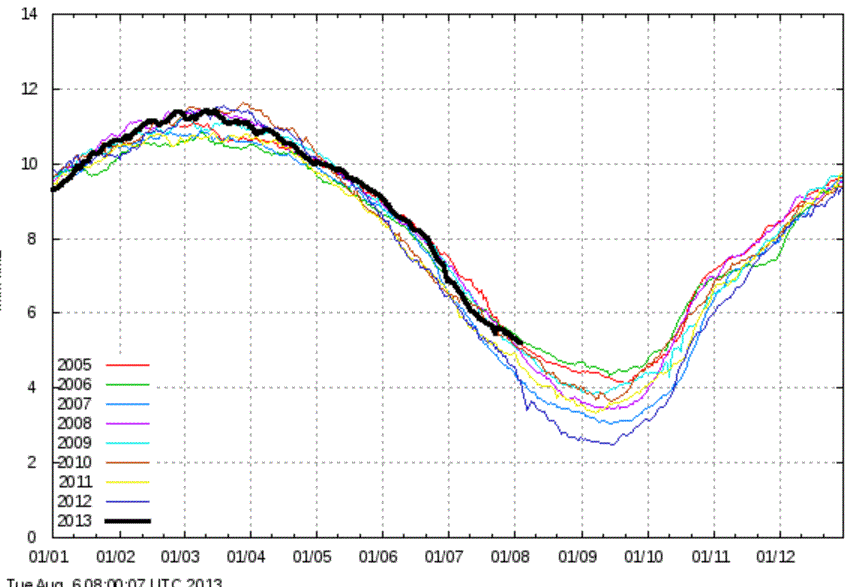That’s 19,000 Manhattans. Arctic open sea water is in a death spiral!
Source: http://ocean.dmi.dk/arctic/old_icecover.uk.php
The chart shows this year’s current sea ice at about 5.2 million sq. km. Last year it was about 3.5 million sq. km. That’s an increase of almost 50%!






It seems like the AGW predictors go out of their way to be as wrong as possible.
Move along nothing to see here 😉
I think this graph is more up to date and more impressive!
http://ocean.dmi.dk/arctic/icecover.uk.php. Its most likely the end of AGW theory as this was the untouchable icon of the TEAM
But then there is this which claims that we’re still significantly below the 30 year average.
http://nsidc.org/arcticseaicenews/
Honestly, this is you guys:
http://youtu.be/cXT1fb_TkX4
Indeed, King Arthur here pretty much depicts the skeptics. You warmists no longer have a leg to stand on. Sea ice is growing, global temperatures aren’t rising, RWP and MWP were warmer, sea level rise is constant, sensitivity is far lower…you blame cold on warming…
Poor John,
eiher his communication skills are lacking or (in case he didn’t try being sarcastic) his knowledge of standard deviation is missing. Then again, signifigance is a matter of definition (watch the pea…).
In any case, the new DMI chart http://ocean.dmi.dk/arctic/icecover.uk.php is really interesting, particularly since they are using SD1 as reference.
Love the way alarmists use the “30 year average” or longer for ice coverage, knowing full well that in the 70s arctic ice was so everywhere that some scientists were predicting an ice age.
No Tricks Zone is an excellent site, but you should be including the information that the DMI graph shows the extent of sea ice covering 30% and above of the sea surface. It is indeed excellent data but it needs qualifying.
True. (Of course, most Arctic ice extent measurements are for 15% coverage.)
Hi Pierre, Off topic, sorry.
Amazon UK will release the book : The Neglected Sun on 12 September and are taking pre-release orders at £10.99, a big discount to the Amazon USA price. This may be of interest to your English readers and followers in Europe.
My pre-release order is in and I know what I will be reading in the 2nd half of next month.
I’m rather suspicious of using 1979-2000 or 1979-2012 averages since these are incorporating a trend, especially their standard deviation, which is wrong for this type of data.
[…] Danish Meteorological Institute: Arctic Sea Ice Now 1.7 Million Square Kilometers Over Last Year! […]
Let’s say for a second that the gigatons of CO2 we are pumping into the atmosphere are not causing climate change. It is causing the acidification of the oceans, which threatens the entire food chain.
Bottom line: You can’t pretend that human activity isn’t changing the globe, and it’s not for the better.
Why has life not been destroyed the last time CO2 was 10 times higher than today?
Why do snail shells survive rain, which is naturally slightly acidic?
Why do corals survive huge diurnal pH swings?
http://en.wikipedia.org/wiki/Buffer_solution
Why do climate scientists eager to prove the end of life under “ocean acidification” really like to achieve the desired pH not by adding CO2 but by adding, for instance HCl (after all, pH equals pH, right? or maybe it does make a difference to life forms?)
Why are there plants, algae and fish in forest creeks, which are naturally slightly acidic? You say “it threatens the food chain”.
Personally, I love trout.
The vast spaces of the pacific far from the coasts are known as “oceanic deserts” for their near total absence of plankton.
Maybe life doesn’t like an alkaline ocean all that much. The most productive areas of the sea are near river deltas, where slightly acidic sweetwater enters the sea.
The desire of climate scientists to warn of ANY change as always negative is bizarre. They have learned that that is how to get funding. They would never dream of characterizing ANY change as positive.
A low Arctic sea ice extent is nothing new over the last 100 years. It is the norm over the last 11,000 years. What’s the problem? Soot? Natural climate oscillations? Lack of satellite data pre-1965 data? PS the Polar Bears survived them all!
http://adsabs.harvard.edu/abs/2007AGUFMPP11A0203F
http://dx.doi.org/10.1175/1520-0442(2004)017%3C4045:TETWIT%3E2.0.CO;2
[…] […]